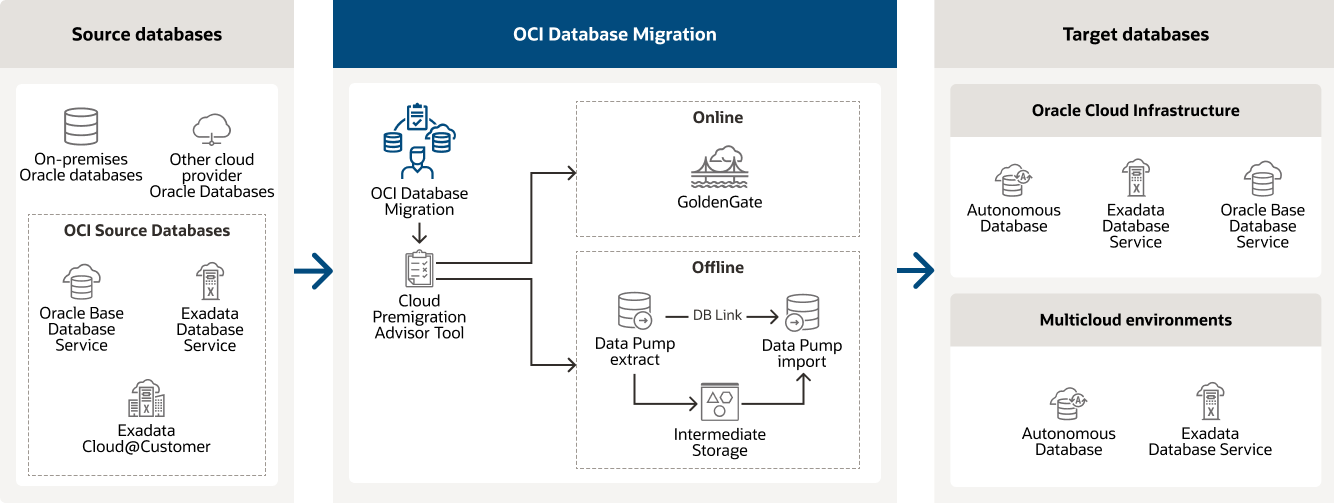OCI Database Migration für Oracle Databases
OCI Database Migration migriert Oracle Database von On-Premises- oder Cloud-Bereitstellungen zu OCI- und Partner-Clouds wie Oracle Database@Azure. Im Rahmen der benutzerfreundlichen grafischen Nutzererfahrung werden dabei die Migrationsworkflows validiert und verwaltet. Die Migration für Oracle Databases nutzt Zero Downtime Migration, Cloud Premigration Advisor Tool, Data Pump und GoldenGate auf transparente Weise, um sichere, fehlertolerante und inkrementelle Migrationen sicherzustellen.
Features des Migrationsservices:
Funktionsweise einer Migration
 Die unterstützten Quelldatenbanken können sich On-Premises, in OCI oder bei anderen Cloud-Anbietern befinden. Bei der Verwendung des OCI Database-Migrationsservice registrieren die Benutzer Quell- und Zieldatenbanken und wählen zwischen einer Online- oder Offline-Migration aus. In der Validierungsphase bewertet Cloud Premigration Advisor die Kompatibilität von Quelle und Ziel, sucht nach potenziell problematischen Inhalten und gibt Empfehlungen ab. Nach der Behebung sämtlicher Fehler werden die Daten zunächst über Data Pump geladen, wobei der Benutzer zwischen dem Laden des Ziels über einen Zwischenspeicher in Object Store oder über einen direkten Datenbanklink zwischen der Quell- und der Zieldatenbank wählen kann. In einem Online-Szenario verwendet die fortlaufende Replikation nach dem ersten Laden GoldenGate.
Die unterstützten Quelldatenbanken können sich On-Premises, in OCI oder bei anderen Cloud-Anbietern befinden. Bei der Verwendung des OCI Database-Migrationsservice registrieren die Benutzer Quell- und Zieldatenbanken und wählen zwischen einer Online- oder Offline-Migration aus. In der Validierungsphase bewertet Cloud Premigration Advisor die Kompatibilität von Quelle und Ziel, sucht nach potenziell problematischen Inhalten und gibt Empfehlungen ab. Nach der Behebung sämtlicher Fehler werden die Daten zunächst über Data Pump geladen, wobei der Benutzer zwischen dem Laden des Ziels über einen Zwischenspeicher in Object Store oder über einen direkten Datenbanklink zwischen der Quell- und der Zieldatenbank wählen kann. In einem Online-Szenario verwendet die fortlaufende Replikation nach dem ersten Laden GoldenGate. Quellen und Ziele
OCI Database Migration unterstützt die folgenden Datenbankquellen und -ziele. Zu den Cloud-Zielumgebungen gehören OCI und Oracle Database@Azure. Die Flexibilität einer logischen Migration ermöglicht Versionsupgrades und Änderungen der Zielplattformen.
 OCI Database Migration unterstützt die folgenden Versionen von Oracle Quelldatenbanken: 11g, 12c, 18c und 19c, Standard- sowie Enterprise-Versionen. Diese Bereitstellungen können auf OCI oder OCI Classic sowie auch auf Amazon RDS erfolgen. Die Konfigurationen beinhalten Standard-Datenbankinstanzen, Oracle RAC One Node und Oracle RAC. Bei den Zielplattformen kann es sich um Autonomous Databases, sowohl ATP wie auch ADW, gemeinsam genutzt oder dediziert, handeln. Diese können auch gemeinsam verwaltete Datenbanken wie Base Database Service auf VM, Bare Metal oder Exadata Cloud Service sein.
OCI Database Migration unterstützt die folgenden Versionen von Oracle Quelldatenbanken: 11g, 12c, 18c und 19c, Standard- sowie Enterprise-Versionen. Diese Bereitstellungen können auf OCI oder OCI Classic sowie auch auf Amazon RDS erfolgen. Die Konfigurationen beinhalten Standard-Datenbankinstanzen, Oracle RAC One Node und Oracle RAC. Bei den Zielplattformen kann es sich um Autonomous Databases, sowohl ATP wie auch ADW, gemeinsam genutzt oder dediziert, handeln. Diese können auch gemeinsam verwaltete Datenbanken wie Base Database Service auf VM, Bare Metal oder Exadata Cloud Service sein. Migrationsworkflows
Die Migrationsworkflows erfüllen sowohl einfache wie komplexe betriebliche Anforderungen, ohne dass fortgeschrittenere DBA-Kenntnisse erforderlich sind. Die Migrationen können unabhängig davon, ob Anwendungen online oder offline sind, ausgeführt werden. Auch die Migration über Firewalls hinweg ist möglich. Bei lang andauernden Migrationen sind Quell- und Zieldateien immer verfügbar, ohne dass die Leistung der Quelldatenbank beeinträchtigt wird. Wenn die Migration auch eine Modernisierung beinhaltet, können die Workflows auch Versionsupgrades und Änderungen bei der Hardwareplattform ermöglichen.
| Oracle Base Database Service | Exadata Database Service | Autonomous Database | |
|---|---|---|---|
| Logische Offline-Migration | Ja |
Ja |
Ja |
| Logische Online-Migration | Ja |
Ja |
Ja |
Integrierter Migration Advisor
Ein umfassender diagnostischer Advisor ist in den Migrationsworkflow integriert. Der Advisor priorisiert Erwartungen, schlägt Lösungen vor und erstellt Reparaturskripte. Die Nutzer können die Details interaktiv überprüfen und entweder die Warnungen ignorieren, die Quellobjekte ausschließen oder Reparaturen durchführen. Durch den komfortablen Ablauf dieses unerlässlichen Arbeitsschritts wird der Migrationsworkflow optimiert.
 Der Prozess des Migration Advisors umfasst fünf Schritte. 1: Identifikation der Quell- und Zielversionen. 2: Identifikation von Ausnahmen in der Form „Aktion erforderlich“, „Prüfung erforderlich“ und „Prüfung empfohlen.“ 3: Darstellung von Funden, einschließlich von Ausnahmedetails und Reparaturempfehlungen sowie Bereitstellung von Reparaturskripten. 4: Die Benutzer ergreifen Maßnahmen in Bezug auf die Funde, einschließlich dem Akzeptieren, der Ausführung von Reparaturskripten, dem Ablehnen oder dem Ausschließen. 5: Nach dem Durchführen der Maßnahmen wird der Advisor erneut ausgeführt. Zusätzliche Schaltflächen ermöglichen es Ihnen, eine Demonstration dieses Prozesses anzuschauen oder durchzulesen.
Der Prozess des Migration Advisors umfasst fünf Schritte. 1: Identifikation der Quell- und Zielversionen. 2: Identifikation von Ausnahmen in der Form „Aktion erforderlich“, „Prüfung erforderlich“ und „Prüfung empfohlen.“ 3: Darstellung von Funden, einschließlich von Ausnahmedetails und Reparaturempfehlungen sowie Bereitstellung von Reparaturskripten. 4: Die Benutzer ergreifen Maßnahmen in Bezug auf die Funde, einschließlich dem Akzeptieren, der Ausführung von Reparaturskripten, dem Ablehnen oder dem Ausschließen. 5: Nach dem Durchführen der Maßnahmen wird der Advisor erneut ausgeführt. Zusätzliche Schaltflächen ermöglichen es Ihnen, eine Demonstration dieses Prozesses anzuschauen oder durchzulesen. Weitere Ressourcen zu OCI Database Migration
-
Ressourcen
- Database Migration Methods Planning Advisor
- Dokumentation
- LiveLab für Offlinemigration
- LiveLab für Onlinemigration
- Schrittweise Anleitung: Agentbasiert (PDF)
- Schrittweise Anleitung: Online-basisert (PDF)
- Schritt-für-Schritt-Anleitung: Onlinebasiert für AWS RDS (PDF)
- Schritt-für-Schritt-Anleitung: Online-Migration für ADB auf Oracle Database@Azure (PDF)
- Schritt-für-Schritt-Anleitung: Online-Migration für ADB auf Oracle Database@Google Cloud (PDF)